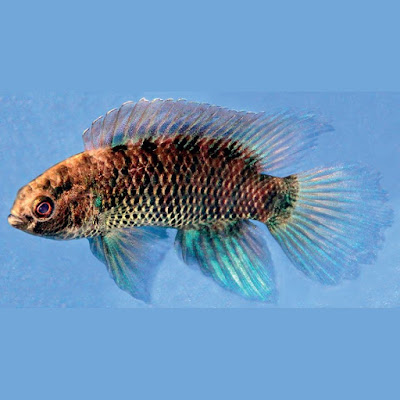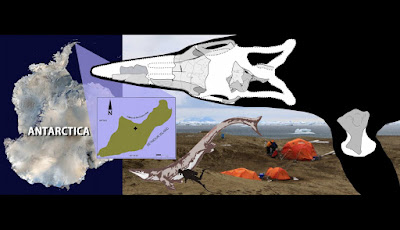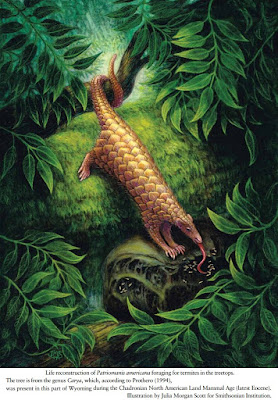[Most Recent Entries] [Calendar View]
Monday, November 7th, 2016
| Time | Event | ||
| 3:34a | [Ichthyology • 2016] Badis pancharatnaensis • A New Percoid Fish Species (Teleostei: Badidae) from Brahmaputra River drainage, Assam, India
Abstract Badis pancharatnaensis, a new percomorph, is described from the Brahmaputra River drainage of Assam, India. It is distinguished from its congeners by having the following combination of characters: a conspicuous black blotch on the superficial part of cleithrum; pointed soft dorsal, anal, and pelvic fins, the 2nd soft ray of pelvic-fin reaching slightly beyond the vent; 13 ‒ 14 pectoral-fin rays; circumpeduncular scales 14 ‒ 17; body depth 28.2 ‒ 33.8% of SL; interorbital distance 7.1 ‒ 9.4% of SL; and 28 number of vertebrae. Key words: Badidae, Badis, taxonomy, new species, River Brahmaputra, Assam. Diagnosis: Badis pancharatnaensis sp. nov. is distinct from all its congeners in having a combination of characters: presence of dark brownish black bars on sides; a series of dark blotches along middle of dorsal-fin; a prominent black blotch on the superficial part of cleithrum; elongate median caudal blotch with a posterior bar surrounding the caudal-fin base; pointed pelvic-fin reaching beyond vent in both the sexes; pointed soft dorsal and anal-fin; 28.2 ‒ 33.8% SL body depth; 7.1 ‒ 9.4% SL interorbital distance; 14 ‒ 17 circumpeduncular scales; 31 ‒ 33 lateral scale rows; 6 ‒ 8 number of gill rakers; and 28 (15+13) number of vertebrae Distribution and habitat. Presently the species is known from Hasila Beel – a riverine wetland of Brahmaputra drainage at Goalpara district, Assam, India (Fig. 4). The type locality is a low lying wetland having dense macrophytic vegetation well connected with the River Brahmaputra and often flooded by the river water; that shows high degree of rise and fall of water level depending on seasonal climatic variations (Fig. 5). The associated fish fauna caught along with the species were Amblypharyngodon mola, Anabas testudineus, Channa gachua, Lepidocephalichthys guntea, Mastacembelus armatus, Macrognathus pancalus, Puntius sophore and Trichogaster fasciata which commonly occur in the region. Etymology. The species is named after the historical place called ‘Pancharatna’ in Goalpara district of Assam, India. Sudem Basumatary, Hrishikesh Choudhury, Ratul A. Baishya, Dandadhar Sarma and Waikhom Vishwanath. 2016. Badis pancharatnaensis, A New Percoid Fish Species from Brahmaputra River drainage, Assam, India (Teleostei: Badidae).Vertebrate Zoology. 66(2); 151-156. http://www.senckenberg.de/files/content/f | ||
| 2:40p | [Paleontology • 2017] Kaikaifilu hervei • A New Large Mosasaur (Squamata, Mosasauridae) from the upper Maastrichtian of Antarctica
Highlights • A new mosasaur from Antarctica. • The second skull known in the continent. • A new genus and species of a large austral mosasaur. Abstract We present a large, fragmentary skull and the humerus of a mosasaur (Squamata, Mosasauroidea) recovered from upper Maastrichtian beds of the López de Bertodano Formation in Marambio (=Seymour) Island, Antarctica. The material belongs to a large, adult individual with marked heterodonty as well as unusual humeral features. Different phylogenetic analyses returned the studied specimen within the Tylosaurinae, while the unique features of the skull and humerus allow distinguish it from the unique Antarctic known tylosaurine species, Taniwhasaurus antarcticus (Novas et al., 2002), as well as from other known Late Cretaceous mosasaurids from the Southern Hemisphere, thus, justifying the erection of a new taxon, Kaikaifilu hervei gen. et. sp. nov. The different dental types documented in the specimen studied have been previously recorded through isolated teeth from the same locality and were subsequently referred to several genera. This new find and its importance to comprehend the previously known fragmentary records strongly suggests that the diversity of Antarctic mosasaurids could be more reduced than previously interpreted, including taxa which are different to the genera and species from the Northern Hemisphere. The new material represents the youngest occurrence of tylosaurines in Antarctica. Keywords: Marine reptiles; Mosasaurs; Upper Cretaceous; Marambio Island; Antarctic Peninsula Systematic paleontology Squamata Oppel, 1811 Mosasauridae Gervais, 1853 Russellosaurina Polcyn and Bell, 2005 Tylosaurinae Williston, 1897 Kaikaifilu gen. nov. Tylosaurinae indet.: In Otero, 2012. Tylosaurinae gen. et sp. nov.: Otero et al., 2015 Type species: as for the only known species within the genus, Kaikaifilu hervei sp. nov., below. Derivation of name. From the Mapudungun language of the ancient people of southern South America. From the Mapuche cosmology, Kai-Kai filú is the almighty giant reptile owner of the seas, rival of Treng-Treng filú, both creators of the lands through their continuous fight that causes the earthquakes, volcanoes, tsunamis and all the events that molded the earth where we live (pronunciation: Khai-khai feelóo). Kaikaifilu hervei sp. nov. Holotype. SGO.PV.6509. Fragmentary skull preserved in several blocks, including part of the maxillae and the premaxillar, frontal, prefrontals, part of the parietal, partial cast of the braincase, cast of the right orbit, a portion of the right pterygoid, a partial cast of the meckellian canal of one dentary, near 30 isolated teeth, fragments of the mandible, and the proximal part of the left humerus. Type Locality. Marambio Island, Antarctica, about 1500 m south from the López de Bertodano Bay. Horizon and Age. López de Bertodano Formation, Klb9 sensu Macellari (1988), Manumiella bertodano Interval Zone ( Bowman et al., 2012) and Pachydiscus riccardi Zone ( Olivero, 2012), upper Maastrichtian. Derivation of the name. Honoring Dr. Francisco Hervé, Chilean geologist, for their major contribution to the knowledge of the geology of Chile and Antarctic Peninsula. Diagnosis. Specimen with the following unique combination of characters: Presence of a prominent lateral process anterior to the orbits, conformed by the posterior end of the prefrontal and the anterior end of the postorbitofrontal; well-marked heterodonty including both faceted and non-faceted functional teeth with very soft striations; articular head of the humerus very thick dorsoventrally; K. hervei differs from other mosasaurids from the WBP in the following features: it differs from Tylosaurus (‘Leiodon’) haumuriensis and from the genus Taniwhasaurus (Ta. antarcticus, Ta. oweni and Ta. mikasaensis) by possessing a well-marked heterodonty, condition absent in the two latter genera; it also differs from these taxa on the frontal midline forming an internarial process which is absent in Ta. mikasaensis (premaxillar extends far beyond external naris) and seems to be absent in Ta. antarcticus; K. hervei differs from Moanasaurus mangahouangae in the outline of the frontal which is axially shorter in the latter and without anterolateral concave margins; K. hervei also differs from Rikisaurus tehoensis in having a frontal contacting the pineal foramen, and by the possession of a preorbital constriction of the rostrum. Unique known specimen here referred to K. hervei comprises the largest known skull of a mosasauroid from the Southern Hemisphere. Conclusions SGO.PV.6509 comprises a fragmentary skull and fragmentary humerus of a single specimen recovered from upper Maastrichtian levels (lower Klb9 unit) of the López de Bertodano Formation in Marambio Island, Antarctica. This is here identified as a large mosasaurid with prominent anterorbital processes, an axially elongated and triangular frontal that extends between the external naris, a well-marked heterodonty and a dorsoventrally massive humerus. Morphological features of SGO.PV.6509 differ from all known mosasaurids from the Southern Hemisphere and especially from the better known austral tylosaurine, Taniwhasaurus antarticus. Thus, a new genus and species, Kaikaifilu hervei, is proposed here. This new skull from the upper Mastrichtian of Antarctica represents the best evidence on the presence of very large tylosaurines on high latitudes (65°) of the Southern Hemisphere prior to the K/Pg boundary. Previous to this research, this clade remained poorly documented in high latitudes. The marked heterodonty of SGO.PV.6509 suggest that several taxa previously reported from the Upper Cretaceous of Antarctica and based on isolated teeth, should be reviewed under the new evidence, since most of them appear to match with the different dental types of the specimen here described. Rodrigo A. Otero, Sergio Soto-Acuña, David Rubilar-Rogers and Carolina S. Gutstein. 2017. Kaikaifilu hervei gen. et sp. nov., A New Large Mosasaur (Squamata, Mosasauridae) from the upper Maastrichtian of Antarctica. Cretaceous Research. In Press. DOI: 10.1016/j.cretres.2016.11.002 | ||
| 3:22p | [PaleoMammalogy • 2016] Skeletal Anatomy of the North American Pangolin Patriomanis americana (Mammalia, Pholidota) from the Latest Eocene of Wyoming (USA)
Patriomanis americana is the only pangolin (Mammalia, Pholidota), living or extinct, known from the Western Hemisphere. It derives from latest Eocene (Chadronian North American Land Mammal Age) deposits from central Wyoming and western Montana. Since its initial description more than 40 years ago based on a partial skeleton, several nearly complete skeletons have been discovered, together including nearly every bone in the skeleton. This taxon is thus not only the most completely preserved fossil pangolin but is also among the best preserved of any Eocene mammal taxon. In the present study we have prepared a detailed, bone-by-bone description of the osteology of Patriomanis, comparing it with other well-known fossil pangolin skeletons (Eomanis, Euromanis, Cryptomanis, and Necromanis), as well as representatives of the three extant pangolins genera (Manis, Smutsia, Phataginus). We provide a catalog of all known Patriomanis specimens and their provenance and an extensive series of measurement tables incorporating the comparative taxa. We analyze the alpha-level taxonomy of the genus, concluding that all specimens should be kept in a single species, Patriomanis americana, based on currently available fossil material. We summarize the taxonomic and phylogenetic position of Patriomanis and discuss its implications for the biogeographic history of the order Pholidota. We analyze the paleobiology of Patriomanis, concluding that it was likely a myrmecophagous, arboreal animal with a prehensile tail. Last, we discuss its paleoecology, suggesting that its late appearance in the Eocene record, during a time of global cooling, may imply that earlier pangolins are waiting to be discovered in the Eocene record of Asia and North America. KEY WORDS: Eocene, fossils, morphology, osteology, pangolins, Patriomanis, Pholidota, skeleton, skull. Timothy J. Gaudin, Robert J. Emry and Jeremy Morris. 2016. Skeletal Anatomy of the North American Pangolin Patriomanis americana (Mammalia, Pholidota) from the Latest Eocene of Wyoming (USA). Smithsonian Contributions to Paleobiology. 98; 1-102. Paleo Profile: North America's Pangolin https://blogs.scientificamerican.com/lae |
| << Previous Day |
2016/11/07 [Calendar] |
Next Day >> |








